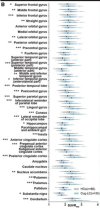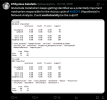You are using an out of date browser. It may not display this or other websites correctly.
You should upgrade or use an alternative browser.
You should upgrade or use an alternative browser.
Systemic increase of AMPA receptors associated with cognitive impairment of long COVID, 2025, Fujimoto et al.
- Thread starter SNT Gatchaman
- Start date
Would that theory require the patient to show sensitivity to MSG?In one of my algorithmic runs, glutamate has been identified as a key factor for MECFS symptoms.
I would think upregulating receptors related to learning would happen in specific locations in the brain relevant to learning, but figure 2B seems to show that AMPAR density was increased pretty much everywhere in this study. Would be good to know in what regions learning increases AMPAR.A cursory look at info around AMPA receptors seems to suggest that learning increases the density of them on the surface of neurons. If the density of these receptors on neurons are a marker of how well a brain works i.e. ongoing learning and connection making, perhaps the people with Long covid who made it to the trial are more likely to be well educated (versus those who didn't find out about the trial or couldn't marshal the resources to take part). I don't know yet how the controls were recruited, but if, for example, they were paid, perhaps they were less likely to be well educated?

True, but they seem to say they also found correlations between AMPAR density and brain fog measures in similar regions within the patient cohort as they did between the patients and the controls, which makes artifacts related to different runs less likely as the reason for the findings:Also, we have seen papers before underlining how important it is in scan studies that controls are included in the same runs as the disease participants. If the controls were scanned in a separate study, that means that there is an additional source of variation.
In addition, we noted brain regions where SUVRWM and the scores of the Picture naming and Figure Recall, which are RBANS subcategories, were negatively correlated (Fig. 2C and E), most of which were identified as areas where AMPAR density was elevated in patients with Cog-LC compared with those in HCs (Fig. 2D and F).
Edit: Though maybe the within-patient cognitive score correlations are not great evidence because they only mention correlations in 2 out of 17 total cognitive scores.
Still, 'figure recall' is one of the most significant scales in terms of difference from controls (table 1), and it's also one of the two within group correlations.
Last edited:
rapidboson
Senior Member (Voting Rights)
I can't help but wonder if it's possible they are interpreting the results backwards?“Therefore, the upregulated [¹¹C]K-2 SUVRWM in patients with Cog-LC may indicate increased surface-expressed AMPAR density. Therefore, non-competitive antagonists of AMPAR, such as perampanel, may be a therapeutic candidate for Cog-LC. This should be tested in future randomized controlled trials.”
Maybe this is the only available non-competitive AMPAR antagonist?
I haven't read the paper, but this quote seems to me as if they're suggesting that the increase in AMPAR is at fault and thus artificially blocking it would/could restore cognitive function.
But what if the increase in AMPAR expression is in fact the brain trying to compensate for something going wrong elsewhere e.g. a dysfunction of AMPAR, a deficiency in glutamate or disruptions in glutamate/GABA balance or something else along those lines? I'm by no means a neuroscientist.
In that case, blocking AMPAR could make things even worse?
Jonathan Edwards
Senior Member (Voting Rights)
But what if the increase in AMPAR expression is in fact the brain trying to compensate for something going wrong elsewhere e.g. a dysfunction of AMPAR, a deficiency in glutamate or disruptions in glutamate/GABA balance or something else along those lines? I'm by no means a neuroscientist.
In that case, blocking AMPAR could make things even worse?
Interesting thought.
Dolphin
Senior Member (Voting Rights)
Sebastian Ocklenburg, Ph.D.
The Asymmetric Brain
Long Covid
Brain Fog in Long COVID Linked to Increase in AMPA Receptors
New research sheds light on why brain fog is a common symptom of long COVID.

Brain Fog in Long COVID Linked to Increase in AMPA Receptors
Many patients with long COVID experience brain fog, but the reasons are not well understood. A new study links brain fog to a type of neurotransmitter receptor.
Agree. My first thought was is this a compensatory mechanism in response to excess glutamate?I can't help but wonder if it's possible they are interpreting the results backwards?
Last edited:

